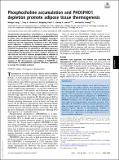Phosphocholine accumulation and PHOSPHO1 depletion promote adipose tissue thermogenesis
Author(s)
Jiang, Mengxi; Chavarria, Tony E; Yuan, Bingbing; Lodish, Harvey F; Huang, Nai-Jia
DownloadPublished version (1.477Mb)
Publisher Policy
Publisher Policy
Article is made available in accordance with the publisher's policy and may be subject to US copyright law. Please refer to the publisher's site for terms of use.
Terms of use
Metadata
Show full item recordAbstract
© 2020 National Academy of Sciences. All rights reserved. Phosphocholine phosphatase-1 (PHOSPHO1) is a phosphocholine phosphatase that catalyzes the hydrolysis of phosphocholine (PC) to choline. Here we demonstrate that the PHOSPHO1 transcript is highly enriched in mature brown adipose tissue (BAT) and is further induced by cold and isoproterenol treatments of BAT and primary brown adipocytes. In defining the functional relevance of PHOPSPHO1 in BAT thermogenesis and energy metabolism, we show that PHOSPHO1 knockout mice are cold-Tolerant, with higher expression of thermogenic genes in BAT, and are protected from high-fat dietinduced obesity and development of insulin resistance. Treatment of mice with the PHOSPHO1 substrate phosphocholine is sufficient to induce cold tolerance, thermogenic gene expression, and allied metabolic benefits. Our results reveal a role of PHOSPHO1 as a negative regulator of BAT thermogenesis, and inhibition of PHOSPHO1 or enhancement of phosphocholine represent innovative approaches to manage the metabolic syndrome.
Date issued
2020Department
Whitehead Institute for Biomedical Research; Massachusetts Institute of Technology. Department of Biology; Massachusetts Institute of Technology. Department of Biological EngineeringJournal
Proceedings of the National Academy of Sciences of the United States of America
Publisher
Proceedings of the National Academy of Sciences